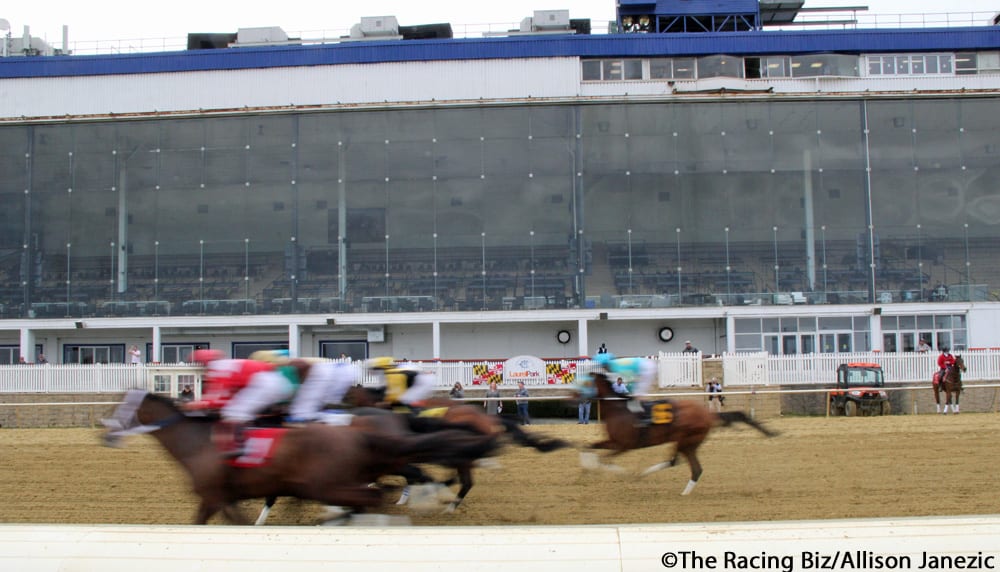[et_pb_section admin_label=”section”][et_pb_row admin_label=”Row”][et_pb_column type=”1_4″][et_pb_text admin_label=”Text” background_layout=”light” text_orientation=”left” use_border_color=”off” border_color=”#ffffff” border_style=”solid”]
![]()
[/et_pb_text][/et_pb_column][et_pb_column type=”3_4″][et_pb_text admin_label=”Major advertisers” background_layout=”light” text_orientation=”left” use_border_color=”off” border_color=”#ffffff” border_style=”solid” module_id=”Major advertisers”]

by Linda Dougherty
Earlier this month, The Jockey Club announced that an analysis of data from its Equine Injury Database (EID) showed a reduction in the rate of fatal injury for the fourth consecutive year and a 23 percent drop since 2009.
The EID is based on injuries that resulted in fatalities within 72 hours from the date of the race, for thoroughbreds only, and excludes races over jumps.
Its data showed that, across all surfaces, ages, and distances, the fatality rate dropped from 1.62 per 1,000 starts in 2015 to 1.54 per 1,000 starts in 2016. The overall rate of 1.54 per 1,000 starts is the lowest since the EID started publishing annual statistics in 2009.
[/et_pb_text][et_pb_text admin_label=”All advertisers” background_layout=”light” text_orientation=”left” use_border_color=”off” border_color=”#ffffff” border_style=”solid”]
That’s good news for the industry, but for those interested in what the overall injury rate was in the mid-Atlantic region in 2016 as compared to 2015, however, that information is not available. While all Midlantic tracks participate in the EID, only a handful self-report, or make their data publicly available: Delaware Park, Laurel Park and Pimlico.
Bob Curran, Vice President of Corporate Communications for The Jockey Club, said that when data for the injury database began to be collected in 2009, it was predicated upon its being confidential information. It has only been since March 2012, that racetracks have been able to voluntarily publish their statistics from the EID (located in the “Safety Initiatives” section of The Jockey Club website). Overall, 25 tracks self-reported during 2016, and their aggregate rate was 1.41.
“The decision, in my mind, was rather simple,” said Sal Sinatra, president and general manager of the Maryland Jockey Club, in explaining why he chose to have data from Pimlico and Laurel Park available online. “It’s easy to defend transparency regardless of the stats. In my view, any higher rates should be discussed and resolved. The fact we have the Preakness Stakes also weighs into trying to be proactive on the safety of our surfaces. Any time we publish these stats we are opening up ourselves to criticism and we should be prepared to defend or explain them.”
[/et_pb_text][et_pb_text admin_label=”Text” background_layout=”light” text_orientation=”left” use_border_color=”off” border_color=”#ffffff” border_style=”solid”]
[/et_pb_text][et_pb_text admin_label=”2nd part of story” background_layout=”light” text_orientation=”left” use_border_color=”off” border_color=”#ffffff” border_style=”solid”]
In Maryland, Pimlico reported a decrease in the number of fatalities per 1,000 starters, 1.47 in 2016 vs. 2.43 in 2015. The track, however, ran nine fewer days in 2016, resulting in 839 fewer starts.
Laurel Park ran 23 more days in 2016 vs. 2015, which resulted in 1,801 more starts and an uptick in the number of fatalities per 1,000 starts of 1.79 vs. 0.97.
Overall, the rate in Maryland was up slightly, from about 1.4 per 1,000 starts in 2015 to 1.74 this year.
Delaware Park, which has run virtually the same number of race dates for the last four years, saw a dramatic drop in its fatality rate in 2016 despite having its most starts since 2012.
Delaware’s number of fatalities plunged to just 0.41 per 1,000 starts, a marked improvement from 2.47 in 2015. Only two fatalities occurred in 2016 from 4,868 starters, vs. 12 fatalities from 4,858 starters in 2015.
“We’re in the business of transparency,” said John Wayne, executive director of the Delaware Thoroughbred Racing Commission, in commenting about the Stanton oval’s decision to publish its information. “We have nothing to hide. The honesty and integrity of racing is the most important thing.”
All Penn National Gaming, Inc. properties, including the mid-Atlantic’s Penn National and Charles Town Races, report information to the EID, but do not publish its fatality statistics.
“We report (to The Jockey Club) all racing injuries for research and statistical purposes,” said Eric Johnston, director of racing operations at Penn National. “However, we do not allow the information to be shared publicly, to avoid misinterpretation.”
Johnston said that the track requests anonymous self reporting from horsemen on all minor injuries that may occur during training hours, to monitor track conditions and trends during that time. This information, based on severity, is also report to the EID.
Chris McErlean, vice president at PNG, said that the company was one of the first to participate in the EID when it started.
“PNG tracks also conduct a review of every catastrophic breakdown with interviews of trainers, vets and other individuals associated with the horse in question,” noted McErlean. “This process has been adopted as a ‘best practice’ by many other tracks and jurisdictions.”
While PNG chooses not to publish its data, McErlean said that four of PNG’s five thoroughbred racetracks reported year-end fatality figures below the national average, with several of the tracks reporting their lowest figures since tracking began.
Monmouth Park also participates in the EID but does not publish the data.
“We constantly strive for the safest surface possible,” said Bill Knauf, vice president of business operations at the Oceanport track. “Last year we had one of our lowest (fatality) percentages since keeping these statistics, and are very proud of the consistency and safety of our track.”
Knauf said that the EID fatality statistic is used internally for analysis and is shared with The Jockey Club, and one they do not want the public to misinterpret.
Parx Racing did not respond to a request for comment for this article.
[/et_pb_text][et_pb_text admin_label=”Minor advertisers” background_layout=”light” text_orientation=”left” use_border_color=”off” border_color=”#ffffff” border_style=”solid”]













